Share via:
Your Blackstone Griddle just arrived that you were waiting for so long. Now you have just set it for cooking some sizzling hot bacon.
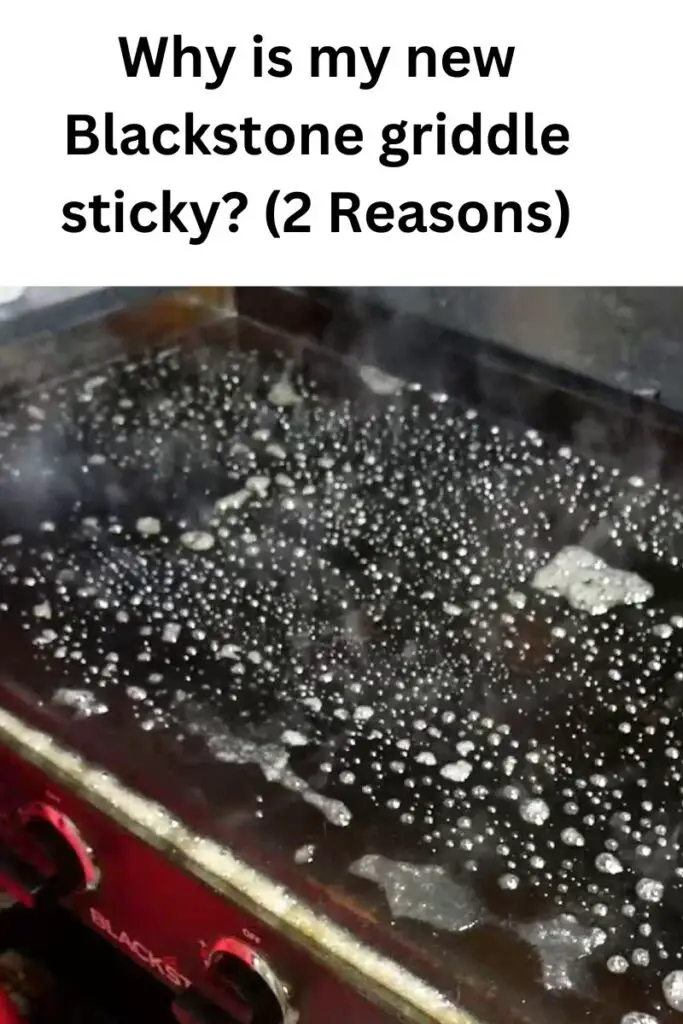
But. Oh, it’s so sticky!! You’re so scared that why is Blackstone griddle sticky out of box? Did you get scammed? No, don’t worry and panic. It’s normal.
why is my Blackstone sticky? The stickiness you notice on a new Blackstone griddle is just a chemical that the factory has applied as a protective covering. Basically, it’s a wax-like inhibitor that is usually used by manufacturers for the products that need to be shipped. They apply this protective barrier to protect the griddle from any kind of corrosion in the warehouse or during shipping.
Let’s find out the in-depth answer to your doubts.
Blackstone Griddle Review (BEST STARTER GUIDE)
Why Is My New Blackstone Griddle Sticky Out Of Box?
You might be assuming that a griddle could be only sticky when it’s seasoned or simply there’s some oil applied to it.
But it’s not like this. Stop expecting a smooth and even surface Blackstone griddle out of the box. It’s normal for a new griddle to always be tacky and sticky.
If your new Blackstone griddle is sticky right out of the box, or you notice a sticky residue on Blackstone griddle it’s likely due to the protective coating that manufacturers often apply to prevent rust during storage and shipping.
This coating can sometimes feel sticky or tacky when you first receive the griddle.
You have to clean, and season it for the first time to get a smooth surface griddle top. The stickiness you noticed is just a wax-like inhibitor that the factory has applied as a protective covering.
It was typically applied to U.S firearms to protect them from rust. Now it is used by various machine manufacturers as a protective covering.
The same thing is followed by Blackstone to protect their griddles. This wax-like inhibitor causes sticky spots on Blackstone griddle. And you have to clean and season it for the first time to remove that toxic material and get a smooth surface griddle.
If your Blackstone is sticky, even after cleaning and seasoning it properly for the first time, then there can be two main reasons for it.
- You haven’t seasoned it properly
- You haven’t cleaned it properly
Let’s have a look at how to clean and season your new Blackstone griddle.
How to Get Glue Off Blackstone Griddle Or Remove Sticky Residue From Griddle?
Blackstone griddles are a staple in professional kitchens and restaurants. One of the most common complaints is that when you open your griddle for the first time, you notice a sticky top or glue on Blackstone griddle.
Don’t worry…
Blackstone griddle tops typically have a protective layer of chemicals that are intended to protect the griddle from rusting, corrosion, and other damage.
Which causes the surface to get sticky.
We certainly need to clean it. Otherwise, we’ll just end up consuming unsafe food with chemicals.
Here’s a step by step instructions to follow when Blackstone is sticky and how to deep clean it.
How to deep clean Blackstone Griddle for the first time?
1. Use Scouring Pad
The first thing you should do is rub the griddle surface with a scouring pad or sand paper.
Yes, I am damn serious. Sandpaper makes things smooth by scraping the unnecessary material. Pass your fingers on the surface of the griddle before using sandpaper and then afterward. You’ll feel the difference.
Take sandpaper of 120 grit and rub it very lightly on the griddle top.
Do not apply too much pressure or do it forcefully. Take it smooth and slow, as you have to make it smooth not to scrape the paint off the top. It’s just about removing the chemical.
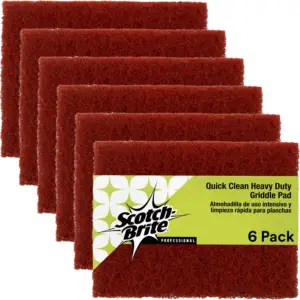
2. Clean it with soap-water
The next step is to dip a towel into soap water. Simple dish wash or a detergent into the water. Wrinkle to remove excess water and then rub it on the griddle surface.
Here I won’t tell you to only use it once. Many people recommend only using soapy water for the first time.
But I guess you can use it whenever you want. But for the first time, it is done to remove the chemical material.
After cleaning it with soap water, dip the towel into clean water and again wrinkle to remove excess water. Rub it on the surface and then clean it completely.
Now feel the surface with your hands again. You’ll feel a cleaner and smoother surface.
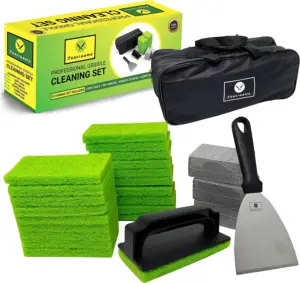
Do you have to season Blackstone Griddle out of the box?
Yes, absolutely!
Unfortunately, Blackstone doesn’t make pre-seasoned grills yet. So you have to season a new Blackstone griddle to prevent stickiness while cooking.
Not only does it make a non-stick surface, but a good seasoning adds a nice flavor to the meal too. Moreover, it forms a protective layer from rust and damage to your new Blackstone griddle.
How to season my Blackstone Griddle for the first time?
If Blackstone sticky, follow a few steps to season your Blackstone griddle for the first time.
- After you have cleaned the griddle thoroughly, now is the time to turn on the burners. Blackstone recommends putting it on high heat for about 10 to 15 minutes.
- Here, I would recommend for a safe side to start from low for 3-4 minutes and then take it to the highest. Also, before turning on the burners, make sure the surface top is completely dry.
- Once you notice the surface top changing colors, it’s time to put in some oil. At this point, the flat top is too hot. Apply oil with caution. Use a long spatula for it.
- Put 2-3 tablespoons of oil on the top and then spread it on the entire surface with the help of paper towels and tongs. Don’t ignore the corners and sides. Spread it all over. Leave it for 15 minutes. Let the oil burn.
- After the griddle turns black and smoke comes out, turn off the burner. Let it cool down. When the smoke slows down, repeat the process with a thin layer of oil.
Here, lesser oil and multiple layers are the secrets to a perfect seasoned griddle! Too much oil will destroy your seasoning shortly.
How long does it take to season a Blackstone Griddle for the first time?
While it only takes roughly 5 minutes to apply a layer of oil and spread it, you have to apply multiple layers. Also, it takes time for the oil to smoke and then wait for it to cool down. Smoking and cooling take 15-20 minutes.
Hence, applying one layer takes approximately 30 minutes. And if you’re making three layers, then it would take 1 and a half an hour as a whole.
What is the best oil to season Blackstone Griddle?
Any oil can be the best oil for seasoning a Blackstone Griddle until it has a high smoke point. Blackstone describes the smoke point as the point at which fats in the oil start to break down. And it is the formula to give your food a burnt-grilled taste.
So whichever oil you use, keep the high smoke point in your mind. It must be around 400-500 degrees F.
Some of the options include avocado oil, sunflower oil, peanut oil, vegetable oil, and extra virgin olive oil. But the best one recommended by Blackstone is their own griddle seasoning and cast iron conditioner. It’s a good blend of oils, perfect for seasoning a Blackstone griddle.
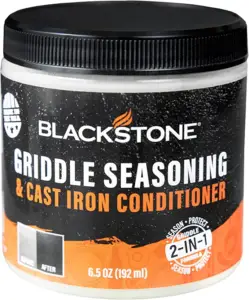
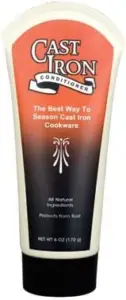
Mold on Blackstone Griddle (6 STEPS TO CLEAN MOLDY GRIDDLE)
How To Remove Blackstone Sticker Residue
If you have sticker residue on Blackstone griddle or any other surface, you can follow these steps to remove it:
- Peel Off as Much as Possible: Carefully peel off as much of the sticker or label as you can without using excessive force. This helps remove the bulk of the sticker material.
- Use Cooking Oil or Olive Oil: Apply a small amount of cooking oil or olive oil onto a soft cloth or paper towel. Gently rub the sticker residue with the oil-soaked cloth. The oil can help break down the adhesive.
- Rubbing Alcohol or Nail Polish Remover: If oil doesn’t work, you can try rubbing alcohol or nail polish remover. Apply a small amount to a cloth and gently rub the residue. Make sure to test a small, inconspicuous area first to ensure that the alcohol or remover won’t damage the surface.
- Warm Soapy Water: Mix warm water with a few drops of dish soap. Dampen a cloth with the soapy water and gently scrub the residue. Rinse the area with clean water afterward.
- Commercial Adhesive Remover: If the residue is stubborn, you can use a commercial adhesive remover. Follow the instructions on the product and be cautious when using it on certain surfaces, as it can potentially damage finishes.
- Scrubbing Pad or Plastic Scraper: For tougher residue, you can use a non-abrasive scrubbing pad or a plastic scraper. Be gentle to avoid scratching the surface.
- Reapply Heat: If you’re dealing with sticker residue on a metal surface like the griddle, you can also try reapplying heat to soften the adhesive. Use a hairdryer or a heat gun on low heat, and then gently peel off the residue.
Always test any cleaning method on a small, inconspicuous area first to ensure it doesn’t damage the surface or finish. Once the residue is removed, clean the area again with mild soapy water to remove any remaining traces of the cleaning agent.
Why is My Blackstone Griddle Sticky Even After Proper Seasoning?
You might be curious that “Why is my griddle sticky after seasoning?” even after you have cleaned and seasoned your griddle perfectly.
What’s the reason for the Blackstone griddle sticky after seasoning?
The primary cause for the sticky griddle top is that it has a very thick layer of oil applied.
A properly seasoned griddle has only a thin layer of oil that quickly burns into the surface and creates a nonstick surface that lasts.
There are a few other reasons for the Blackstone sticky after seasoning.
1- Use of Sugary Sauces
The food you are cooking may contain sauces or seasonings that have sugar in them. This is the main culprit.
Sugar, when cooked on high heat, caramelizes, making the food prone to sticking. Some examples include barbecue sauce, fruit glazes, honey mustard, and teriyaki sauce.
2- Not pre-heated
Preheating the griddle ensures an even temperature and heat flow to the food, saving it from sticking.
If your griddle is not properly heated for the right amount of time, your food will stick.
How Hot Does A Blackstone Griddle Get?
3- Temperature imbalance
Too high or too low temp also stands to reason for stickiness. If you set the temperature at its lowest, the food will, no doubt, cook slowly.
Yet, there will be more time for the juices to come out and cause food to stick. If you set the temp to its highest, it will burn the food too soon and make it prone to stickiness.
How do you get sticky residue off Blackstone griddle?
The best way to protect your Blackstone griddle from sticky residue or gunk is to clean it after cooking. Here is a step-by-step process to follow.
How to Clean Blackstone Griddle After Cooking (5- Steps)
Don’t use harsh chemical cleaners to clean a steel or cast iron griddle top.
Sometimes, even after cleaning, the blackstone surface is still coated with black gunk that will not come off. Avoid using harsh chemical cleaners on it, if you want to prolong the life of your cast-iron griddle.
You can soak it in hot water and vinegar mixture overnight twice, and rub it with a grill stone afterward.
Wrap Up: Why Is My New Blackstone Griddle Sticky?
So what do you do when you first get your Blackstone Griddle? Clean and season it properly to prepare for perfect cooking.
If you notice a tacky and sticky surface of your griddle when you unbox it, don’t worry. Also, don’t presume it to come pre-seasoned.
That Blackstone sticky surface is a protective barrier applied by the manufacturer to protect it during shipping. Thorough cleaning and seasoning will remove it.
RELATED ARTICLES YOU’LL LOVE TO READ
10 Blackstone Hacks (Griddle Tips & Tricks)
Top 4 Reasons For Blackstone Uneven Heating[Solutions]
How To Store Blackstone Griddle For Winter? (STORAGE TIPS)
How Hot Does A Blackstone Griddle Get?
Why is Blackstone Not Getting Hot Enough? (6 Reasons)
Is Blackstone griddle coating coming off? (Quick Fix)
20 Best Blackstone Camping Recipes [Easy & Quick]
FAQs
Why does my Blackstone leave Black residue?
The black residue or speck you may see on the Blackstone griddle is likely harmless in small amounts and just carbon deposits.
Oils and fats can, when overheated, will lead to carbon deposits in your food.
Cooking oils with low smoke points cause carbonization at a high temperature and residue rubbed off with the food from the griddle.
Although unpleasant, it didn’t seem toxic in such small amounts.
Another reason for Blackstone’s black residue is seasoning.
The seasoning is not meant to last forever and can start to flake after the first few meals you cook.
The oil or wax coating on the griddle will start to disintegrate with high heat and will not hold up for long.
I am a writer, editor, and publisher of Grillcuisines.com – an online blog dedicated to sharing grilling tips, accessories, and recipes to encourage more people to get outside and grill.
I’m off to find out the different types of grill foods, their seasons, and how to conduct outdoor cooking properly. I’ll also show you some of my grill-worthy cooking tools & accessories!


